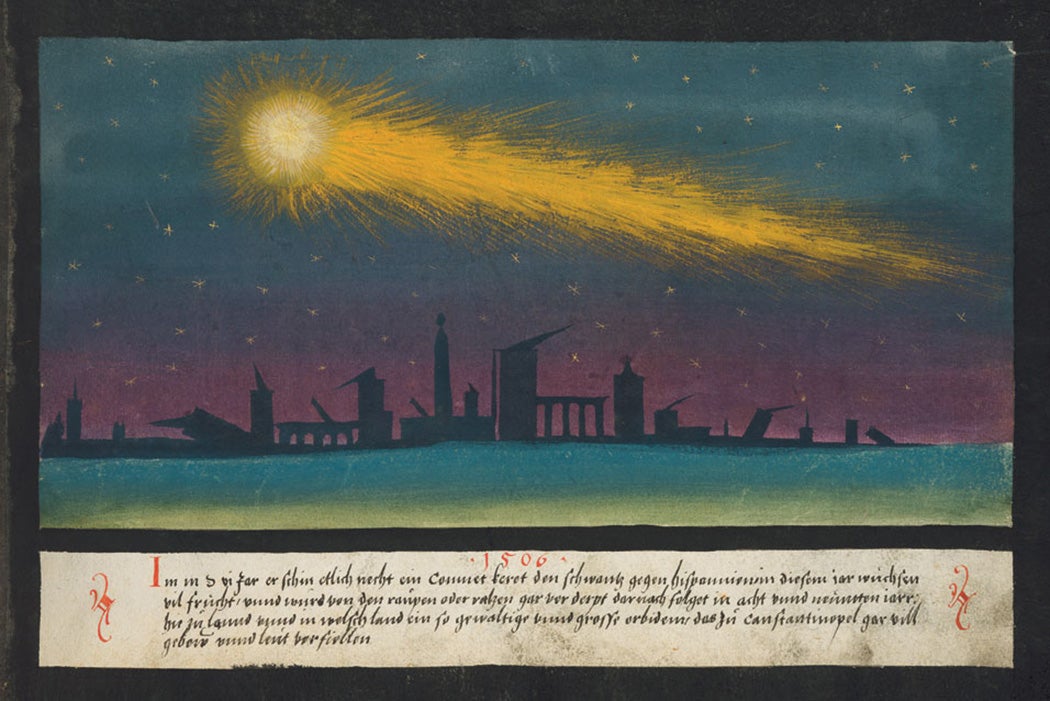Nowadays, the appearance of a comet, like the recently soaring NEOWISE, is likely to inspire wonder and excitement. But for much of human history, a comet was more likely to inspire blood-curdling fear.
“Almost always in classical times comets were regarded as portents, generally as warnings of dire events,” writes historian Duane Koenig. (They were also sometimes “harbingers of happy things,” like the birth of heroes, prophets, or kings.)
Ancient records show that thousands of years ago, “Persians and Koreans viewed comets as of evil nature and often [announced] war with the country in whose direction the tail pointed,” writes Koenig. Over in Rome, comets were an object of fear and worship. Historian Geraldine Herbert-Brown finds that Pliny the Elder paid “particular attention to comets, and the terror they had caused humans in the course of history.” According to Pliny, a comet would appear at “crucial intervals” starting in 49 BCE, “glaring terribly when Nero succeeded Claudius, and then continuously throughout Nero’s principáte.”
Comets—also called “bearded stars”—were consistently seen as bad news for rulers. Around 70 CE, the Roman emperor Vespasian was cautioned about a comet. “He contended the bearded star did not concern him because he was bald. It threatened his neighbor, the king of the Parthians, who was hairy,” writes Koenig.
In 1066, the Battle of Hastings was famously preceded by an appearance of Halley’s comet, which would be recorded as a portent predicting the defeat of the Anglo-Saxon king in the Norman Conquest.
The fifteenth century witnessed the beginnings of modern astronomy and a more scientific approach to comets. But even into the sixteenth century, writes art historian Roberta J. M. Olson, “the attitudes towards celestial events remained unresolved.” Scientists like Copernicus and Tycho Brahe attempted to fight the superstitions. (Martin Luther called comets “harlot stars.”) Yet during the turbulence of the Reformation, belief in comets as portents actually spread, writes Olson. In 1528, a comet “the color of blood” was reported, supposedly “caus[ing] some people to fall sick because it was so horrible,” adds Koenig. “Some died of fear.”
With the invention of the telescope in 1608, the mystery of comets started to lessen. The work of Galileo, followed by Isaac Newton and Edmund Halley, “would, once and for all, establish that comets were physical objects in rational, elliptical orbits around the sun,” writes Olson.
Weekly Newsletter
But some paranoia persisted: It was believed that children born under a comet would have a hard life, and that it was unlucky to start a business with a comet in the sky. In 1910, the appearance of Halley’s comet caused panic, fueled by swindlers who sold pills to ward off “cometary poison.” The misinformed believed that the comet’s tail would fill the atmosphere with poison gas; in preparation for the event, some people “hid in wells, supplied caves with provisions, or stored oxygen bottles,” writes Koenig.
We’ve come a long way since 500 BCE, when a comet could start a war or portend death. It’s almost surprising that in the year 2020, NEOWISE was one of the few events that didn’t seem to be a herald of the apocalypse.







